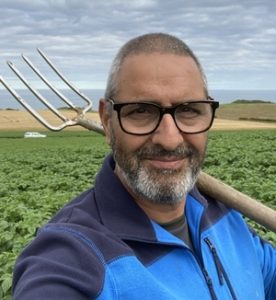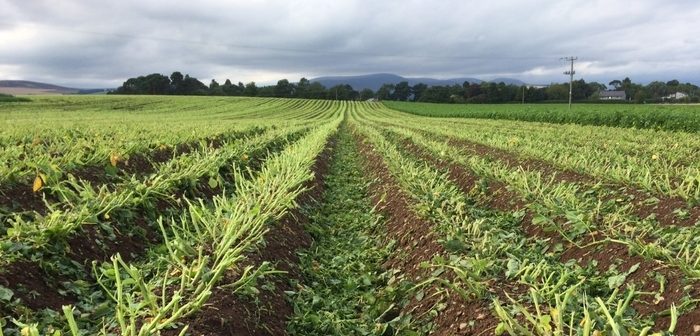Following their first full season of diquat free desiccation, and potentially armed with greater knowledge gleaned from “real” non-trial conditions without a diquat safety net, many potato growers should now have an even better understanding of what it takes to achieve good desiccation says agronomist John Sarup, Co-Director of SPUD Agronomy and Consultancy Limited.
Formerly with the Scottish Agricultural College, Mr Sarup set up SPUD Agronomy in 2012 and, together with business partner Rob Blades they cover 4,500ha of potatoes, mainly across the Northern counties and Scottish borders where he advises on seed, ware and processing crops.
“I began looking at diquat free desiccation strategies around 10 years ago when I set up the company, long before diquat’s withdrawal. Early results from flailing followed by the application of a protoporphyrinogen oxidase inhibitor (PPO) were variable, mainly due to a lack of understanding on how PPOs worked back then coupled with a trial and error approach to discovering the key factors that influence crop senescence.

John Sarup
“Once we’d worked out how to maximise the efficacy of the PPOs by applying them in bright sunny conditions and target them correctly at the severed stems rather than the foliage then results improved significantly” he confirms.
Fast forward to 2021 and John now feels that the vast majority of critical factors that can either make or break desiccation have been fully identified and, it is now more a case of fine tuning the information already out there to ensure successful crop burn-down.
“During the last 10 years, combining knowledge gained from my own work with other trial observations, I’ve identified 6 key areas that can make a significant difference to desiccation outcomes. The first of these 6 areas is temperature and timing of the PPO application to maximise its efficacy. Always apply PPOs early to mid-morning in bright, sunny conditions giving the chemical maximum time to kill cells.
“The second key is soil moisture at the time you begin desiccation. This is important as it will affect the speed of skin-set. If you can find a dry weather window and begin the process with a dry soil then you’ll achieve quicker skin-set, critical for crops going into store.
“The third key is better early season planning, not only to reduce the early season weed burden, but also focusing on field layouts to ensure the flail can turn without damaging headlands – or, even planting a different variety on the headlands that you can then harvest as green-top will help to make the later desiccation process easier.
“For the fourth key area we need to return to the PPO application. It’s important that growers always apply PPOs in minimum water volumes of 300l-400l/ha to ensure good coverage. For the fifth and sixth keys, I would highlight both nitrogen management to control haulm size and understanding if the variety being grown is determinate or indeterminate which often dictates the nutrition management strategy,” adds Mr Sarup.
In terms of desiccation methods, Mr Sarup believes a flail approach followed by 1 or 2 PPO applications is the quickest and most economical approach, providing the grower has the right soil type and weather conditions for successful flailing.
“My advice is to do no pre-sprays prior to flailing and, when flailing the crop, leave 15-30cm of exposed stem behind with any foliage completely separated from stems. Flailing is then followed up by an application of Gozai (pyraflufen-ethyl) at its full rate of 0.8l/ha + methylated vegetable oil alongside an application of Ranman Top (cyazofamid) to give the crop on going tuber blight protection through desiccation whilst killing any remaining zoospores post flailing.
“When desiccating seed crops I would also recommend going back into the crop with a second spray of Gozai + oil, again at 0.8l/ha, 10 days after the first PPO was applied to make absolutely sure there is no stem regrowth. If growers are unable to flail due to poor weather or soil type then, on a chemical-only strategy, I would recommend Gozai over carfentrazone-ethyl as the first spray in the sequencing. Mainly because I feel that it is more effective in opening up the crop. On prevention of regrowth there is no discernable difference in the performance of the 2 PPOs based on the trial work and customer feedback I’ve received” concludes John.
Calum Cargill of Crop Services (Scotland) Limited advises on 810ha of potatoes per annum covering Perthshire, Angus and Fife where 85% of his customers are certified seed growers.
Mr Cargill first began early desiccation trial work combining flailing with the use of Gozai as his first choice PPO in 2016, not long after the product was launched.
“I definitely feel that I know more now than I did 5 years ago. But, whilst desiccating ware crops is often pretty straightforward in reasonable weather conditions, many of the original issues that I came up against when desiccating seed crops are still significant challenges today, despite my increased knowledge base.
“Seed crops are young and even when tubers reach their target size they want to keep growing. Regardless of whether the desiccation approach is mechanical or chemical risk of virus transmission by aphids and strong possibilities of stem regrowth can make the process very challenging.
“A chemical-only strategy is certainly possible on seed crops but it’s expensive and can take a number of applications to complete the process. Flailing first is certainly quicker, however growers require a reasonably dry weather window to flail effectively. Even in August, this far north that’s not always possible” he adds.
Whilst Mr Cargill is not a keen advocate of nitrogen management, sacrificing the benefits of a bigger potato crop for potentially easier desiccation, he accepts that, in some situations, a compromise is often unavoidable.
“In dry conditions and, on anything but very light soils, my general advice to customers would be to flail and follow up with a PPO such as Gozai at its full rate of 0.8l/ha + oil. If it’s a seed crop then growers must be decisive and, once tubers have reached their target size, a decision to kill the crop should have been made at least 5 days before hand. Flail well to ensure clear separation of foliage and exposed stems, then apply the PPO 24-48 hours later in bright, sunny conditions if possible to maximise its effectiveness.
“Of the 2 PPOs available to growers my personal choice would be Gozai, based on the excellent technical support and advice I receive from Belchim’s technical team. However, when employing a chemical-only strategy both available PPOs must be used in sequence to maximise results” confirms Mr Cargill.




